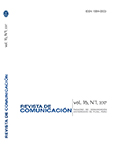
Artícle
Humorousness as creation and reinforcement of network society: the case of Philosophers memes
(Text in Spanish)
References
Abadi, M. (1982). Teoría del chiste. Algunas precisiones. Revista de Psicoanálisis Nº 5. Tomo XXXIX, Buenos Aires.
Abril, G. (2012). Tres dimensiones del texto y de la cultura visual. IC – Revista Científica de Información y Comunicación. Madrid: UCM, pp. 15 – 35.
Aladro, E. (2002). El humor como medio cognitivo. CIC Cuadernos de Información y Comunicación 7, pp. 317-327.
Bajtin, M. (1989). Teoría y estética de la novela. Madrid: Taurus.
Baudelaire, Ch. (1988). Lo cómico y la caricatura. Madrid: Visor.
Bergson, H. (1973). La risa. Ensayo sobre la significación de lo cómico. Madrid: Espasa Calpe.
Castells, M. (2001). La era de la información: economía, sociedad y cultura. Vol I. La sociedad red. Madrid: Alianza.
Deacon, T. W. (2004). Memes as Signs in the Dynamic Logic of Semiosis: Beyond Molecular Science and Computation Theory. Conceptual Structures at Work., Vol. 3127 of the series Lecture Notes in Computer Science, pp 17-31.
Freud, S. (2012). El chiste y su relación con lo Inconsciente. Madrid: Alianza.
Gómez de la Serna, R. (1928). Gravedad e importancia del humorismo. Revista de Occidente, 28 de febrero, pp. 348-360.
Hall, S. (1997). The Work of Representation In Representation: Cultural Representations and Signifying Practises. Stuart Hall ed. London: Sage Cap. 1, pp. 13-74.
Kilpinen, E. (2008). Memes versus signs: On the use of meaning concepts about nature and culture. Journal of the International Association for Semiotic Studies, vol. 2008, pp 171, 196.
Knobel, M. y Lankshear, C. (2005). Memes and affinities: Cultural replication and literacy education. NRC, Miami, November.
Koestler, A. (2002). El humor como acto cognitivo (El acto de creación: Libro I: El bufón). CIC Cuadernos de Información y Comunicación 7, pp. 317-327.
Pirandello, L. (2007). El humorismo. Madrid: Langre.
Sontag, S. (1995). El amante del volcán. Madrid: ALFAGUARA.
